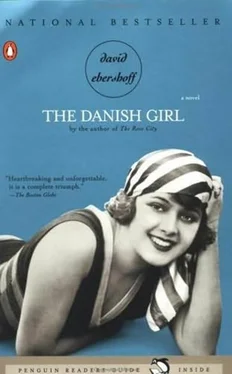“Nothing.”
“Then what ’s wrong with him?” Greta asked.
“In terms of his physical health, nothing at all.”
“What about the bleeding?”
“It’s hard to be sure, but probably nothing more than his diet. Be sure he avoids any stony fruit and fish bones.”
“Do you really think that’s all there is to it? His diet?” Greta took one step back. “Do you really believe he’s a perfectly healthy man, Dr. Hexler?”
“His health is normal. But is he a normal man? Not at all. Your husband isn’t well.”
“What can I do?”
“Do you keep a lock on your wardrobe? To keep him out of your clothes?”
“Of course not.”
“You should do so immediately.”
“What good would that do? Besides, he has dresses of his own.”
“Get rid of them right away. You shouldn’t be encouraging this, Mrs. Wegener. If he thinks you approve of it, he might think it’s all right for him to pretend he ’s Lili.” Dr. Hexler paused. “Then he’ll have no hope. You haven’t been encouraging this, have you? I hope for his sake that you’ve never told him that you approve.”
It was what Greta feared most, that somehow Lili would be blamed on her. That she had somehow harmed her husband. The corridor’s walls were dull yellow and scratched. Next to Greta was a portrait of Dr. Hexler, the type of portrait she used to paint.
One day just a few weeks before, Greta received a telephone call from Rasmussen, saying that Lili had come into the gallery. “I of course recognized her from your paintings,” he said. “But something might have been wrong. She seemed weak, or thirsty.” Rasmussen said he had given Lili a chair, and she quickly fell asleep, one silver bubble on her lips. Soon after, Baroness Haggard came to the gallery with her Egyptian chauffeur. The baroness liked to think of herself as the most current of the aristocracy, and she couldn’t get over the irony-the “modernism,” as she put it-of coming across the paintings’ subject sleeping before the paintings themselves. The gallery filled with the soft leather sound of the baroness’s ostrich gloves applauding “the whole moment.” Five paintings were hanging, paintings done in the heat of late August in southern France, each lit as if from behind by the slow, creeping Menton sun. They showed Lili just as she now was in the chair: tentative, inward, exotic in size and poise, with her large nose and bony knees, her lids oily, her face bright. “The baroness bought all five,” Rasmussen had reported. “And Lili slept through the whole transaction. Greta, is something wrong with her? I certainly hope not. You aren’t keeping her out too late, are you? Take care of her, Greta. For your sake.”
“You’re really not concerned about the bleeding?” Greta asked Dr. Hexler. “Not in the least?”
“Not as much as I am about his delusion that he is a woman,” the doctor said. “Even an X ray can’t cure that. Would you like me to talk to Einar? I can tell him that he ’s injuring himself.”
“But is he?” Greta finally asked. “I mean, is he really?”
“Well, of course. I trust you agree with me, Mrs. Wegener. I trust you’d agree that if this doesn’t stop, we ’ll have to take more drastic measures. That a man like your husband can’t live much of a life. Of course Denmark is very open, but this isn’t about openness. It’s about sanity, wouldn’t you agree with me, Mrs. Wegener? Wouldn’t you agree that there ’s something not quite sane about your husband’s desires? That you and I, as responsible citizens, cannot let your husband free to roam as Lili? Not even in Copenhagen. Not even on occasion. Not even under your supervision. I trust you’ll agree with me that we should do whatever it takes to get this demon out of him, because that is what it is, don’t you agree with me, Mrs. Wegener? A demon. Mrs. Wegener, don’t you agree?”
And just then, Greta, who was thirty and a Californian and who could count at least three instances when she had nearly killed herself by accident-the second, for example, was when she performed a handstand on the teak railing of the Frederik VIII , which first carried her family to Denmark when she was ten-realized that Dr. Hexler knew very little, if anything at all. She’d been wrong, and she heard Einar moan in his bed, behind the folding screen.

Just off the boulevard de Sebastopol, north of Les Halles Centrales, there was a little street that ran for two blocks. Over the years the street ’s name had changed. It was once known as the rue du Poivre-a pepper warehouse had thrived and failed there. When it was known as the rue des Semaines, there was a hotel for returning soldiers. But now it was known-at least colloquially, because the blue-and-white street sign was missing-as the rue de la Nuit. The buildings on the street were black, with coalsoot on the windowsills, on the abandoned gas lamps, in the trough of the pissoir, on the torn awning of the tobacco shop, which also peddled in wheat vodka and girls. The doors on the street were numbered but signless. No one aside from the tobacco shop proprietor, who had a red mustache that caught the crumbs of his morning brioche, seemed to live on the street or conduct any sort of business, legitimate or otherwise. Number 22 was a door with a bubble-glass window, beyond that a hallway that smelled like the sooty pissoir. At the top of the stairs, another door, this one dented with kicks, and beyond that a counter with a woman named, or so she said, Madame Jasmin-Carton, and her Manx cat, Sophie.
Madame Jasmin-Carton was fat but still young. A thick brown fur grew on her forearms, in which her gold chain bracelets sometimes snagged. She once told Einar that one of her girls had gone off and married a Greek prince, leaving Madame Jasmin-Carton with the Manx cat. She also reported that over the years the visitors to her salles de plaisir included ambassadors, a prime minister, and a good dozen counts.
For five francs Madame Jasmin-Carton would give Einar a key chained to a brass bulb. The key admitted him to Salle No. 3, a narrow room with an armchair covered in green wool, a wire wastepaper basket thoughtfully emptied, and two small windows with their black shades drawn. There was a bulb in the ceiling that cast light around the green chair. Behind a smell of ammonia was the trace of something salty and bitter and wet.
It was May now, two sunny, warm days for every cold one. The narrow room was always cold. In the winter Einar had sat in the green chair in his overcoat and watched the puffs of his breath. He hadn’t been coming to Madame Jasmin-Carton’s long enough to know, but he imagined that in August the dim walls-already yellow from tobacco, and streaked-would sweat on their own.
Today, Einar peeled off his jacket, which had panel pockets and a fashionable looped belt. Greta had bought the jacket for Einar, as she did nearly all his clothes; she trusted he knew nothing of how to dress for Paris. Except of course Lili’s clothes: the drop-waist dresses with the matching silk headbands, the kid gloves that pulled past the elbow with pearly clasps, the shoes with the rhinestone ankle straps. Lili bought those herself. In a marmalade jar Einar would set aside Lili’s weekly allowance, and she would spend her way through it in two or three days, her hand reaching into the jar’s narrow mouth and snatching the cen times. The Lili money: that was the entry in Einar’s budget. He would look for francs in the pockets of his gabardine slacks to give her more. If he found none, sometimes Lili would run to Greta, who with Lili only seemed to know the words “yes” and “more.”
Читать дальше













